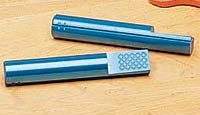
How do you go about choosing the location, layout pattern, and number of bench dog holes to cut when building a workbench?
Carol Reed: The path of holes needs to be in line with the center of the vise and its dog, or in two lines corresponding to two points equidistant on the vise. The distance apart would be a number slightly less than the opening of the vise. That should cover all contingencies.
Michael Dresdner: You could buy a set of plans. These, for instance, will set you back only four dollars. Even if you don’t get all the holes you need, comfort yourself with the knowledge that there are round bench dogs out there for the purchasing. That means even long after the bench is built, you can always add extra bench dog holes with nothing but a hand drill.
Richard Jones: Within reason, I can’t see that it matters much. My bench has holes spaced 145 mm center to center on both the fixed top and the moving L-shaped vise end. The vise has four holes, and there’s more than 300 mm of travel in it. That’s more than enough to select an appropriate pair of dog holes to lock a piece in place. I suspect that with that amount of travel I could manage with the dog holes on the main top spaced at twice the distance they are spaced; i.e. 290 mm, plus.





